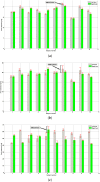Robust Foot Clearance Estimation Based on the Integration of Foot-Mounted IMU Acceleration Data
- PMID: 26703622
- PMCID: PMC4732045
- DOI: 10.3390/s16010012
Robust Foot Clearance Estimation Based on the Integration of Foot-Mounted IMU Acceleration Data
Abstract
This paper introduces a method for the robust estimation of foot clearance during walking, using a single inertial measurement unit (IMU) placed on the subject's foot. The proposed solution is based on double integration and drift cancellation of foot acceleration signals. The method is insensitive to misalignment of IMU axes with respect to foot axes. Details are provided regarding calibration and signal processing procedures. Experimental validation was performed on 10 healthy subjects under three walking conditions: normal, fast and with obstacles. Foot clearance estimation results were compared to measurements from an optical motion capture system. The mean error between them is significantly less than 15 % under the various walking conditions.
Keywords: 3D transformation; driftless integration; foot clearance estimation; inertial measurement unit.
Figures





Similar articles
-
Measurement of foot placement and its variability with inertial sensors.Gait Posture. 2013 Sep;38(4):974-80. doi: 10.1016/j.gaitpost.2013.05.012. Epub 2013 Jun 26. Gait Posture. 2013. PMID: 23810335 Free PMC article.
-
Smoother-Based 3-D Foot Trajectory Estimation Using Inertial Sensors.IEEE Trans Biomed Eng. 2019 Dec;66(12):3534-3542. doi: 10.1109/TBME.2019.2907322. Epub 2019 Mar 26. IEEE Trans Biomed Eng. 2019. PMID: 30932822
-
Inertial sensing algorithms for long-term foot angle monitoring for assessment of idiopathic toe-walking.Gait Posture. 2014;39(1):485-9. doi: 10.1016/j.gaitpost.2013.08.021. Epub 2013 Aug 31. Gait Posture. 2014. PMID: 24050952
-
Enhancing Intelligent Shoes with Gait Analysis: A Review on the Spatiotemporal Estimation Techniques.Sensors (Basel). 2024 Dec 10;24(24):7880. doi: 10.3390/s24247880. Sensors (Basel). 2024. PMID: 39771619 Free PMC article. Review.
-
Analysis of the performance of 17 algorithms from a systematic review: Influence of sensor position, analysed variable and computational approach in gait timing estimation from IMU measurements.Gait Posture. 2018 Oct;66:76-82. doi: 10.1016/j.gaitpost.2018.08.025. Epub 2018 Aug 23. Gait Posture. 2018. PMID: 30170137
Cited by
-
Validity and reliability of wearable inertial sensors in healthy adult walking: a systematic review and meta-analysis.J Neuroeng Rehabil. 2020 May 11;17(1):62. doi: 10.1186/s12984-020-00685-3. J Neuroeng Rehabil. 2020. PMID: 32393301 Free PMC article.
-
Impact-Aware Foot Motion Reconstruction and Ramp/Stair Detection Using One Foot-Mounted Inertial Measurement Unit.Sensors (Basel). 2024 Feb 24;24(5):1480. doi: 10.3390/s24051480. Sensors (Basel). 2024. PMID: 38475012 Free PMC article.
-
Data-Driven Investigation of Gait Patterns in Individuals Affected by Normal Pressure Hydrocephalus.Sensors (Basel). 2021 Sep 27;21(19):6451. doi: 10.3390/s21196451. Sensors (Basel). 2021. PMID: 34640771 Free PMC article.
-
Comparing the Ground Reaction Forces, Toe Clearances, and Stride Lengths of Young and Older Adults Using a Novel Shoe Sensor System.Sensors (Basel). 2024 Oct 26;24(21):6871. doi: 10.3390/s24216871. Sensors (Basel). 2024. PMID: 39517766 Free PMC article.
-
Assessment Methods of Post-stroke Gait: A Scoping Review of Technology-Driven Approaches to Gait Characterization and Analysis.Front Neurol. 2021 Jun 8;12:650024. doi: 10.3389/fneur.2021.650024. eCollection 2021. Front Neurol. 2021. PMID: 34168608 Free PMC article.
References
-
- Benoussaad M., Mombaur K., Azevedo-Coste C. Nonlinear model predictive control of joint ankle by electrical stimulation for drop foot correction; Proceeding of the 2013 IEEE/RSJ International Conference on Intelligent Robots and Systems; IEEE, Tokyo, Japan. 3–7 November 2013; pp. 983–989.
Publication types
MeSH terms
LinkOut - more resources
Full Text Sources
Other Literature Sources
Medical

